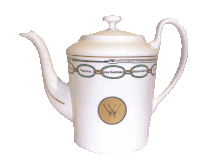 From Wikipedia.com
From Wikipedia.comThe China Room is one of the rooms on the ground floor in the White House, the home of the president of the United States. The White House's collection of state china is displayed there. The collection covers administrations from George Washington's Chinese export china to Bill Clinton's ivory, yellow and burnished gold china commemorating the two-hundredth anniversary of the White House's occupancy by John Adams. The room is primarily used by the First Lady for teas, meetings, and smaller receptions.
McKim Refinishing
Until late 1902 when the room was refinished as a public entertainment space during renovations directed by Charles Follen McKim, this room, along with most of the ground floor of the residence, was used for household work and general storage. McKim rebuilt the room with details from the late Georgian period including robust cove moldings.
The China Collection Begins
In the 1889 Mrs. Benjamin Harrison was the first to start collecting china from previous administrations. Mrs. Harrison displayed the china she collected in Arts and Crafts movement style cabinets in the ground Floor Center Hall. Little value had ever been placed on presidential dinner settings, and damaged china was sold or given away as late as the McKinley administration.
In 1917 First Lady Edith Bolling Wilson became aware of the lack of properly curated White House artifacts through a series of articles in the Washington Post authored by Abby Gunn Baker (1860–1923). Baker had researched the history of the White House over a twenty year period and argued that the history of the house was slipping away, and that without official intervention would be lost. In response Mrs. Wilson surveyed the Ground Floor looking for a room in which to display the growing collection of White House china. Working with White House Chief Usher "Ike" Hoover Mrs. Wilson designated a large room located in the southeast of the Ground Floor as the new "Presidential Collection Room" to be outfitted with built-in cabinetry for the display of White House china[1]. Above the built-in wall cabinets a carved inscription reading CHINA USED BY THE PRESIDENTS was installed.
Truman and Kennedy Periods
Following the Truman renovation, 1949–1952, the walls were paneled in salvaged pine timbers from the house. Architect William Adams Delano detailed the room with bracket molding of mid-Georgian style. The paneling was left unpainted until it was painted ivory as part of redecoration by Stéphane Boudin during the Kennedy administration
Nixon Redecoration
The room was substantially redecorated in 1970 by White House Curator Clement Conger and interior decorator Edward Vason Jones during the administration of Richard Nixon. The Truman era bracketed molding was removed and replaced with a later Federal period cove molding. A red accent color, determined by the red gown in the portrait of First Lady Grace Coolidge, painted by Howard Chandler Christy in 1924 was retained. The vitrine shelves are lined with a similarly colored red velvet.
China Collection
The collection is arranged chronologically beginning to the right of the fireplace on the east wall. While not every administration created their own service, at least minimal amounts of all china services created for the White House are now in the collection. Sizable amounts of some services going back to the early nineteenth century exist and is sometimes used for small dinners in the President's Dining Room on the Second Floor. The Carters favored using pieces of the Lincoln's amaranth purple rimmed china for special occasions. The Reagans, though famous for their red and gold service also enjoyed using the Lincoln china. The Clintons did not take delivery of their state service until near the end of President Clinton's second term. They used the Reagan and Truman services extensively for state dinners, but for small family dinners, especially holidays, favored the Hayes china which depicts American flora and fauna.
Furnishings
The rug is an Indo-Ispahan carpet from the early twentieth century. A cut-glass Regency style chandelier hangs in the China Room. A pair of late eighteenth century tureens on the mantel are glazed in red and green slip, and are the source for the green and red striped silk taffeta draperies. Two high-backed lolling chairs, made early in the nineteenth century and upholstered in ivory and moss green are arranged in front of the portrait of Mrs. Coolidge. An English neoclassical mantel is located on the east wall, and Ferdinand Richardt's "View on the Mississippi Fifty-Seven Miles Below St. Anthony Falls, Minneapolis," completed in 1858 hangs above the mantel.
***shown in the John Adams pattern by Woodmere; for more information, go to:
http://www.woodmerechina.com/whitehouse_items.cfm?item=45




No comments:
Post a Comment